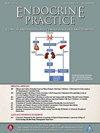Suppressed Renin Status Is a Risk Factor for Cardiocerebrovascular Events in Bilateral Primary Aldosteronism Treated With Mineralocorticoid Receptor Antagonists
IF 4.6
3区 医学
Q2 ENDOCRINOLOGY & METABOLISM
引用次数: 0
Abstract
Objective
Mineralocorticoid receptor antagonists are the recommended medical therapy for bilateral primary aldosteronism (BPA). Patients with BPA have higher risk of cardiocerebrovascular disease (CCVD) than those with essential hypertension. There is no consensus on the criteria to assess the effectiveness of medical therapy for BPA. This study aimed to investigate the incidence of and risk factors for CCVD after medical therapy of BPA.
Methods
We conducted a retrospective cohort study including 240 patients with BPA treated with mineralocorticoid receptor antagonists. The posttreatment plasma renin activity (PRA) was defined as unsuppressed (PRA, ≥1 ng/mL/h); otherwise, it was defined as suppressed. We analyzed the association of posttreatment PRA status with CCVD outcomes.
Results
Of patients with BPA, 7.1% (17/240) developed CCVD at a median follow-up of 5.0 (range, 2.96-7.66) years. Moreover, 57.1% of patients had a PRA of ≥1 ng/mL/h after treatment. Patients with a PRA of <1 ng/mL/h had a higher incidence of CCVD (12.6% vs 2.9%, P < .05) and were at higher risk than those with a PRA of ≥1 ng/mL/h (hazard ratio, 4.50 [95% CI, 1.47-13.83; P < .05]; adjusted hazard ratio, 3.98 [95% CI, 1.22-13.02; P < .05]).
Conclusion
Patients with BPA who receive pharmacologic treatment have a high incidence of CCVD. PRA may be an indicator that mineralocorticoids are being adequately antagonized.
肾素状态受抑制是使用矿物质皮质激素受体拮抗剂治疗的双侧原发性醛固酮增多症患者发生心脑血管事件的一个风险因素。
背景矿物皮质激素受体拮抗剂(MRA)是治疗双侧原发性醛固酮增多症(BPA)的推荐药物。与原发性高血压(EH)相比,双侧原发性醛固酮增多症患者的心脑血管疾病(CCVD)发病率更高。我们进行了一项回顾性队列研究,纳入了 240 名接受 MRA 治疗的 BPA 患者。治疗后血浆肾素活性(PRA)定义为未抑制(PRA≥1ng/ml/h),否则定义为抑制。结果 7.1%(17/240)的 BPA 患者在中位随访 5.0(2.96,7.66)年时发生了心血管疾病。57.1%的患者在治疗后PRA≥1ng/ml/h。与PRA≥1ng/ml/h的患者相比,PRA<1ng/ml/h的患者发生心血管疾病的风险更高(12.6% vs. 2.9%,P<0.05)(HR=4.50,95% CI:1.47-13.83,P<0.05;调整后HR=3.98,95% CI:1.22-13.02,P<0.05)。PRA可能是矿物质皮质激素被充分拮抗的一个指标。
本文章由计算机程序翻译,如有差异,请以英文原文为准。
求助全文
约1分钟内获得全文
求助全文
来源期刊

Endocrine Practice
ENDOCRINOLOGY & METABOLISM-
CiteScore
7.60
自引率
2.40%
发文量
546
审稿时长
41 days
期刊介绍:
Endocrine Practice (ISSN: 1530-891X), a peer-reviewed journal published twelve times a year, is the official journal of the American Association of Clinical Endocrinologists (AACE). The primary mission of Endocrine Practice is to enhance the health care of patients with endocrine diseases through continuing education of practicing endocrinologists.
 求助内容:
求助内容: 应助结果提醒方式:
应助结果提醒方式:


